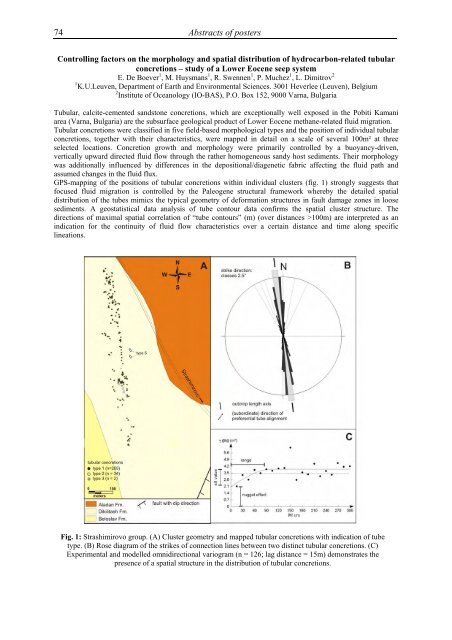Ninth international conference on - Marum
Ninth international conference on - Marum
Ninth international conference on - Marum
Create successful ePaper yourself
Turn your PDF publications into a flip-book with our unique Google optimized e-Paper software.
74<br />
Abstracts of posters<br />
C<strong>on</strong>trolling factors <strong>on</strong> the morphology and spatial distributi<strong>on</strong> of hydrocarb<strong>on</strong>-related tubular<br />
c<strong>on</strong>creti<strong>on</strong>s – study of a Lower Eocene seep system<br />
E. De Boever 1 , M. Huysmans 1 , R. Swennen 1 , P. Muchez 1 , L. Dimitrov 2<br />
1 K.U.Leuven, Department of Earth and Envir<strong>on</strong>mental Sciences. 3001 Heverlee (Leuven), Belgium<br />
2 Institute of Oceanology (IO-BAS), P.O. Box 152, 9000 Varna, Bulgaria<br />
Tubular, calcite-cemented sandst<strong>on</strong>e c<strong>on</strong>creti<strong>on</strong>s, which are excepti<strong>on</strong>ally well exposed in the Pobiti Kamani<br />
area (Varna, Bulgaria) are the subsurface geological product of Lower Eocene methane-related fluid migrati<strong>on</strong>.<br />
Tubular c<strong>on</strong>creti<strong>on</strong>s were classified in five field-based morphological types and the positi<strong>on</strong> of individual tubular<br />
c<strong>on</strong>creti<strong>on</strong>s, together with their characteristics, were mapped in detail <strong>on</strong> a scale of several 100m² at three<br />
selected locati<strong>on</strong>s. C<strong>on</strong>creti<strong>on</strong> growth and morphology were primarily c<strong>on</strong>trolled by a buoyancy-driven,<br />
vertically upward directed fluid flow through the rather homogeneous sandy host sediments. Their morphology<br />
was additi<strong>on</strong>ally influenced by differences in the depositi<strong>on</strong>al/diagenetic fabric affecting the fluid path and<br />
assumed changes in the fluid flux.<br />
GPS-mapping of the positi<strong>on</strong>s of tubular c<strong>on</strong>creti<strong>on</strong>s within individual clusters (fig. 1) str<strong>on</strong>gly suggests that<br />
focused fluid migrati<strong>on</strong> is c<strong>on</strong>trolled by the Paleogene structural framework whereby the detailed spatial<br />
distributi<strong>on</strong> of the tubes mimics the typical geometry of deformati<strong>on</strong> structures in fault damage z<strong>on</strong>es in loose<br />
sediments. A geostatistical data analysis of tube c<strong>on</strong>tour data c<strong>on</strong>firms the spatial cluster structure. The<br />
directi<strong>on</strong>s of maximal spatial correlati<strong>on</strong> of “tube c<strong>on</strong>tours” (m) (over distances >100m) are interpreted as an<br />
indicati<strong>on</strong> for the c<strong>on</strong>tinuity of fluid flow characteristics over a certain distance and time al<strong>on</strong>g specific<br />
lineati<strong>on</strong>s.<br />
Fig. 1: Strashimirovo group. (A) Cluster geometry and mapped tubular c<strong>on</strong>creti<strong>on</strong>s with indicati<strong>on</strong> of tube<br />
type. (B) Rose diagram of the strikes of c<strong>on</strong>necti<strong>on</strong> lines between two distinct tubular c<strong>on</strong>creti<strong>on</strong>s. (C)<br />
Experimental and modelled omnidirecti<strong>on</strong>al variogram (n = 126; lag distance = 15m) dem<strong>on</strong>strates the<br />
presence of a spatial structure in the distributi<strong>on</strong> of tubular c<strong>on</strong>creti<strong>on</strong>s.














